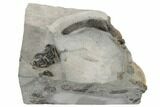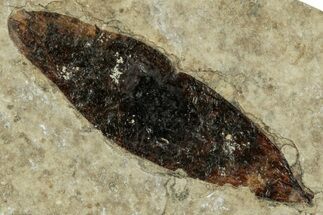This Specimen has been sold.
1.35" Triassic, Fossil Plesiosaur Tooth In Situ - United Kingdom
This is a 1.35" long, tooth from an early Plesiosaur. It was collected from the Triassic, Rhaetic Bone Beds in Aust, Gloucestershire, United Kingdom. This specimen is partially exposed within the rock in which it was found. Overall, the tooth has decent enamel preservation considering how hard this rock is and the difficult preparation process needed to free the specimen from the surrounding stone. The location where this tooth was found is rich with ancient remains and other chunks of bone and teeth can be observed within the rock of this specimen. We have included a display stand for different display options.
Plesiosaurs are typically observed in deposits that are early Jurassic in age. However, skulls and other remains of Plesiosaurs have been found in late Triassic formations, though this is quite rare. Because of the age of this specimen, this tooth is exceptionally special and exciting for collectors.
Plesiosaurs are typically observed in deposits that are early Jurassic in age. However, skulls and other remains of Plesiosaurs have been found in late Triassic formations, though this is quite rare. Because of the age of this specimen, this tooth is exceptionally special and exciting for collectors.
Plesiosaurs were aquatic reptiles. They had small heads, long necks, broad, flattened bodies, short tails and large flippers or paddles. They are one of the best described groups of fossil animals with a total of 110 known species, many from complete or nearly complete fossils. The largest known is Elasmosaurus at 40 feet (12 meters), and the smallest was Thalassiodracon at just under 6 feet (1.5 meters). They first appear in the fossil record near the end of the Triassic Period, starting with Thalassiodracon from about 203 million years ago. They disappear from the fossil record about the time of the Cretaceous-Paleogene Extinction, along with the dinosaurs and most other reptiles.
Plesiosaurs were almost comical in their appearance: small heads full of sharp, cylindrical teeth; wide, comparatively flat bodies; short tails; and four large paddles or flippers. They are so odd-looking that when originally found, the first Plesiosaur fossil was mistaken for a new kid of Pterosaur. Even when the first Plesiosaur went on display, it had its head mounted on the wrong end! Plesiosaur necks could also have large numbers of vertebrae: Albertonectes had 72 in its neck!
Plesiosaurs swam by moving their paddles or flippers in much the same way that modern sea turtles do. This would have made them efficient and maneuverable, but not particularly speedy. Due to their long, thin necks and flippers, it is unlikely that Plesiosaurs left the water. If they did, they would not have been able to travel far. It had long been thought that Plesiosaurs left the water to lay eggs in much the same way as modern sea turtles. Recent evidence seems to prove they bore live young, making theories that they left the water less likely. It is widely held that plesiosaurs were not the fastest swimmers in the sea, cruising to catch their preys of various fish, squid, and other mollusks.
Plesiosaur fossils have been found worldwide. The first described fossil was found in Kansas. Since then, they have been found on every continent. Most commercially available Plesiosaur fossils come from Morocco and Kansas.
Plesiosaurs were almost comical in their appearance: small heads full of sharp, cylindrical teeth; wide, comparatively flat bodies; short tails; and four large paddles or flippers. They are so odd-looking that when originally found, the first Plesiosaur fossil was mistaken for a new kid of Pterosaur. Even when the first Plesiosaur went on display, it had its head mounted on the wrong end! Plesiosaur necks could also have large numbers of vertebrae: Albertonectes had 72 in its neck!
Plesiosaurs swam by moving their paddles or flippers in much the same way that modern sea turtles do. This would have made them efficient and maneuverable, but not particularly speedy. Due to their long, thin necks and flippers, it is unlikely that Plesiosaurs left the water. If they did, they would not have been able to travel far. It had long been thought that Plesiosaurs left the water to lay eggs in much the same way as modern sea turtles. Recent evidence seems to prove they bore live young, making theories that they left the water less likely. It is widely held that plesiosaurs were not the fastest swimmers in the sea, cruising to catch their preys of various fish, squid, and other mollusks.
Plesiosaur fossils have been found worldwide. The first described fossil was found in Kansas. Since then, they have been found on every continent. Most commercially available Plesiosaur fossils come from Morocco and Kansas.
SPECIES
Unidentified Plesiosaur
AGE
LOCATION
Aust, Gloucestershire, United Kingdom
FORMATION
Rhaetic Bone Beds
SIZE
Tooth: 1.35" long, Rock: 3.3 x 2.7"
CATEGORY
SUB CATEGORY
ITEM
#189122
We guarantee the authenticity of all of our
specimens. Read more about our
Authenticity Guarantee.
specimens. Read more about our
Authenticity Guarantee.
 Reviews
Reviews













